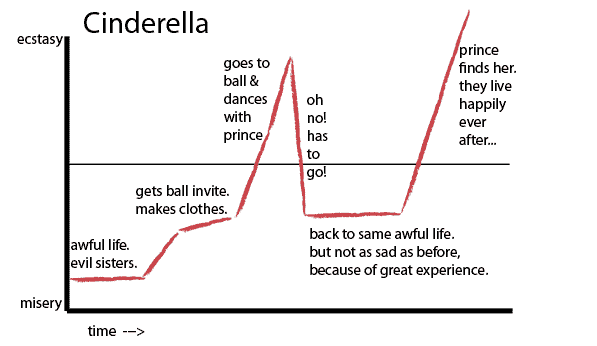Strategic Communications at Work
1) Never communicate to inform.
If you have a goal to inform, Ask yourself why exactly you want to communicate? In cases like these it sometimes turns out that communication isn’t necessary at all. But in most cases you’ll eventually find a more action-oriented goal, such as receiving feedback or making a follow-up appointment to discuss possible collaboration.2) Have a Story Arc in your communication...
3) The GOAL of any business meeting is Inform> Create Interest> Take Action
Your Communication Goals | The Big Idea |
Why do I want to inform my audience? (Guide your reasons for communications with 3 layers of whys.) | Who is my primary audience? Narrowed down to a single person (decision-maker) or persona, who will that be? |
Why does my audience want information from me? (Why were you asked to give the presentation? What is the question behind the question?) | What does my audience care about? |
What do I want my audience to do? | What are the benefits if your audience acts the way you want them to? ...opportunity to improve sales by X% ... |
What would go wrong if I don’t communicate at all? (What's the compelling reason for you to communicate?) | What are the risks if your audience do not? Lost opportunity to... |
Use your underlying goal to focus your story. ..test an app ..get volunteers approval for... ..etc Can you explicitly mention your goal, and what you want your audience to do? | Form your BIG IDEA : Articulate your point of view, Convey what’s at stake, In a single, complete sentence! REFINE & REFRAME |
4) Storyboard helps to craft the message to deliver the solution!
1 | Brainstorm what details you possibly include in the eventual presentation.
|
2 | Edit
|
3 | Get feedback on the storyboard
|

Situation: Functions as a starting point and a common basis. Therefore it primarily contains recognizable and agreed points.

Complication: Spells the reason for acting now. It contains threats / opportunities and the hurdles that need to be overcome.

Question: Asks the question how the hurdles of the C can be overcome. How can prevent the threat or seize the opportunity?

Answer: Provides the answer on how to overcome the hurdles. Explains how this will help deflect the threats or seize the opportunities.
The Overview
The essence above is written with reference from articles and books below :
- Storytelling with Data: Let's Practice! 1st Edition by Cole Nussbaumer Knaflic
- The Analytic Storytelling Team : https://analytic-storytelling.com/en/ (Golden nuggets of wisdom divulged on SCQA and pitfalls)
- Frameworks for workplace communication







Comments
Post a Comment